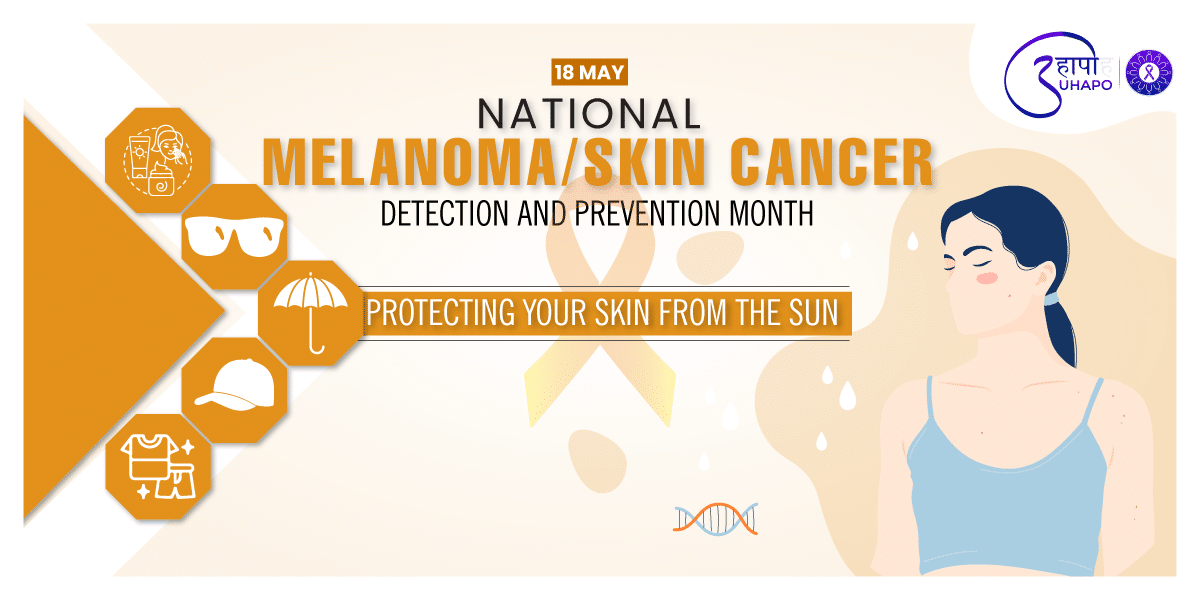National Melanoma/Skin Cancer Detection and Prevention Month – Protecting Your Skin from the Sun
May marks National Melanoma/Skin Cancer Detection and Prevention Month, a critical time to raise awareness about the risks of skin cancer and the significance of early diagnosis and prevention. Skin cancer is the most prominent cancer in India, and melanoma is among the deadliest form of cancer. Protecting your skin from the sun’s damaging ultraviolet (UV) radiation is critical for lowering the risk of skin cancer. This blog will explore the significance of this awareness month, different types of skin cancer, risk factors, and efficient sun protection methods.
Understanding Skin Cancer
Skin cancer develops when skin cells grow uncontrollably due to DNA damage, primarily caused by UV radiation from the sun or tanning beds. There are three major types of skin cancer –
- Basal Cell Carcinoma (BCC): The most common type, often appearing as a flesh-colored bump or a pinkish patch of skin. It usually develops in sun-exposed areas and grows slowly.
- Squamous Cell Carcinoma (SCC): This type appears as a red, scaly patch, wart-like growth, or a sore that doesn’t heal. It also typically occurs in sun-exposed areas and can grow more rapidly than BCC.
- Melanoma: The most dangerous form, melanoma can develop anywhere on the body, often within an existing mole. It appears as a brown or black spot with irregular borders and multiple colors. Melanoma is more likely to spread to other parts of the body if not detected early.
Risk Factors for Skin Cancer
Several factors increase the risk of developing skin cancer, including –
- Excessive Sun Exposure – Prolonged UV exposure is the leading cause of skin cancer. This includes exposure to natural sunlight and artificial sources like tanning beds.
- Fair Skin – Individuals with fair skin, light hair, and light eyes have less melanin and are more susceptible to UV damage.
- History of Sunburns – Severe sunburns, especially in childhood, significantly increase the risk.
- Family History – A family history of skin cancer can indicate a genetic predisposition.
- Personal History – Having had skin cancer increases the likelihood of developing it again.
- Weakened Immune System – Conditions or medications that suppress the immune system can increase the risk.
The Importance of Early Detection
Early detection of skin cancer dramatically increases the chances of successful treatment. Regular self-examinations and professional skin checks are essential. Here are some tips for effective skin checks –
- Perform Monthly Self-Exams: Use a mirror to check your entire body, including hard-to-see areas like your back and scalp. Look for new growths, changes in existing moles, and any sores that don’t heal.
- Follow the ABCDE Rule: Monitor moles for Asymmetry, Border irregularity, Color variation, Diameter larger than 6mm, and Evolution or changes over time.
- Annual Dermatologist Visits: Schedule yearly skin exams with a dermatologist, especially if you have risk factors for skin cancer.
Sun Protection Strategies
Preventing skin cancer starts with protecting your skin from UV radiation. Here are some effective strategies –
- Use Sunscreen – Apply a broad-spectrum sunscreen with an SPF of at least 30 to all exposed skin, even on cloudy days. Reapply every two hours, and after swimming or sweating.
- Wear Protective Clothing – Opt for long-sleeved shirts, long pants, and wide-brimmed hats. Clothes made from tightly woven fabrics offer the best protection.
- Seek Shade – Avoid direct sun exposure, especially between 10 a.m. and 4 p.m. when UV rays are strongest. Use umbrellas or seek shade under trees or structures.
- Wear Sunglasses – Protect your eyes and the sensitive skin around them with sunglasses that block 100% of UV rays.
- Avoid Tanning Beds – Tanning beds emit UV radiation that can significantly increase the risk of skin cancer.
- Be Cautious Near Water, Snow, and Sand – These surfaces can reflect and intensify UV rays, increasing the likelihood of sunburn.
Myths and Misconceptions
Several myths about sun protection and skin cancer persist. It’s important to address these misconceptions –
- “I don’t need sunscreen on cloudy days.” Up to 80% of UV rays can penetrate clouds, so it’s crucial to wear sunscreen regardless of the weather.
- “Tanning beds are safer than the sun.” Tanning beds emit harmful UV radiation that increases the risk of all types of skin cancer.
- “A base tan protects against sunburn.” Any tan is a sign of skin damage, and it does not protect against further UV exposure or reduce the risk of skin cancer.
- “Only fair-skinned people get skin cancer.” While fair-skinned individuals are at higher risk, people of all skin tones can develop skin cancer.
Conclusion
National Melanoma/Skin Cancer Detection and Prevention Month reminds us of the importance of protecting our skin from harmful UV radiation and the critical need for early detection of skin cancer. By understanding the risks, practicing sun-safe behaviors, and conducting regular skin checks, we can significantly reduce the incidence of skin cancer and ensure healthier, safer lives. This May, commit to protect your skin and spread awareness about skin cancer prevention within your community.


6 Replies to “Skin Cancer Detection and Prevention Month”
January 22, 2025
August 5, 2025
June 26, 2025
August 5, 2025
August 2, 2025
August 5, 2025